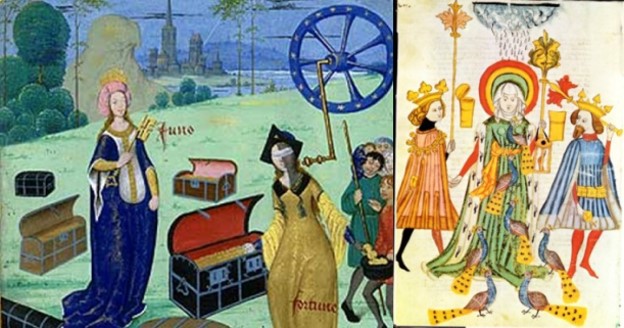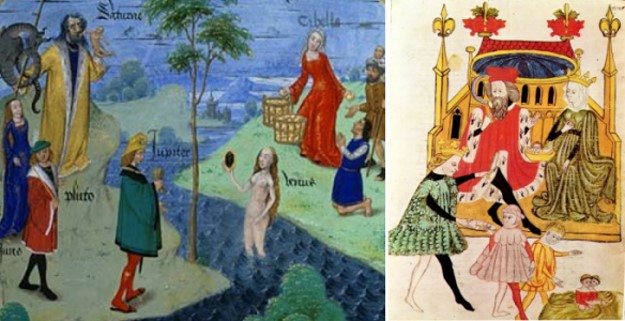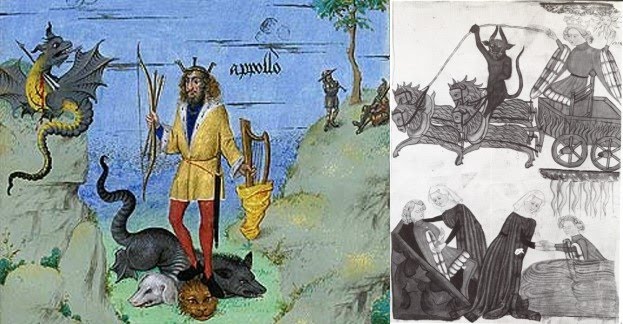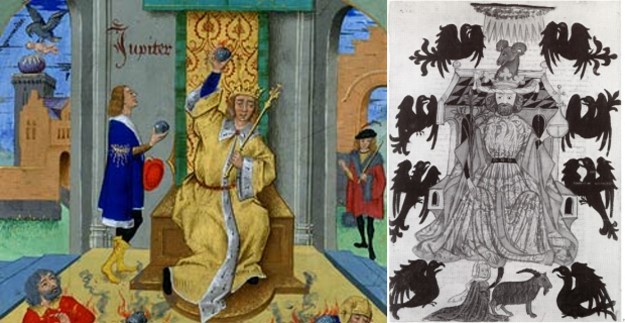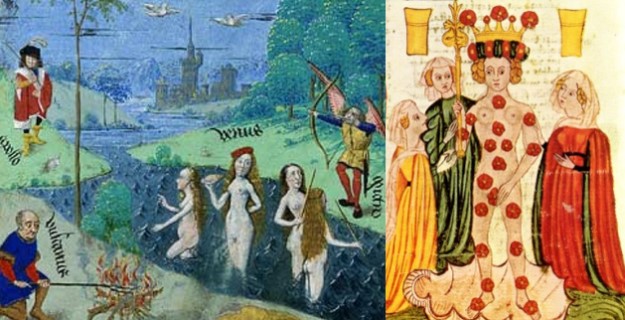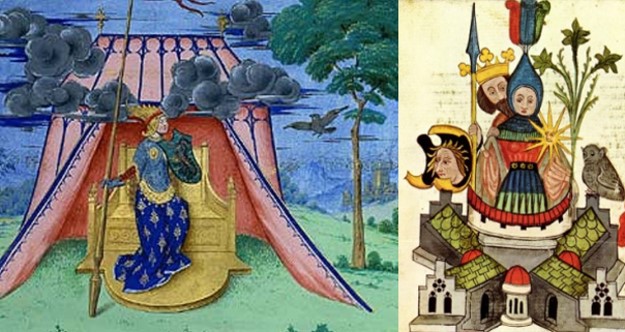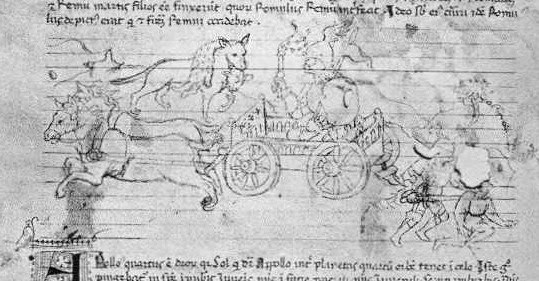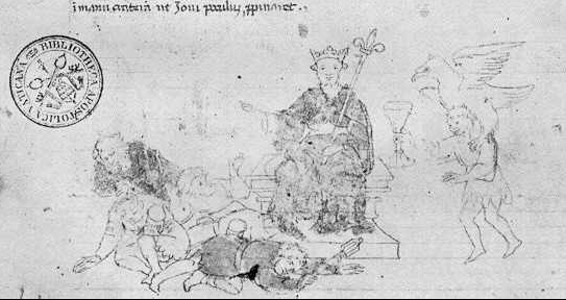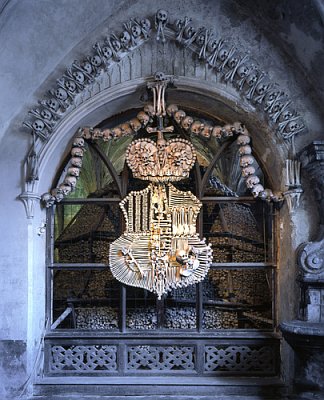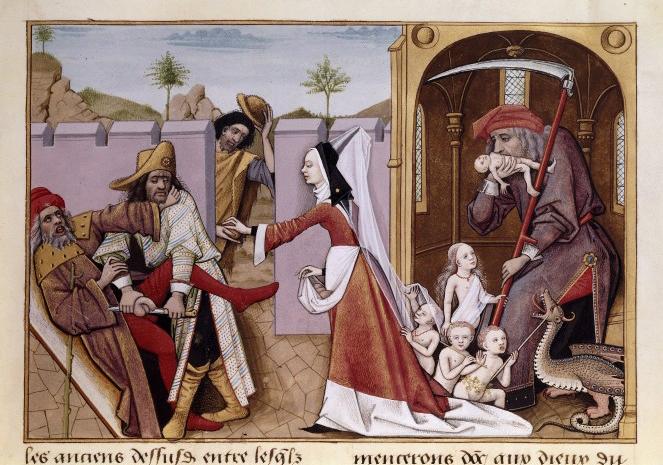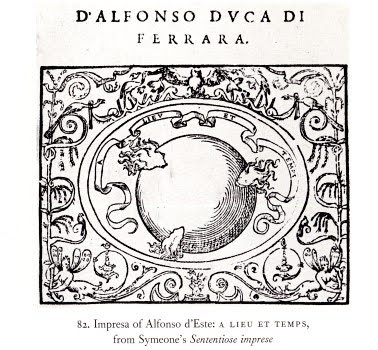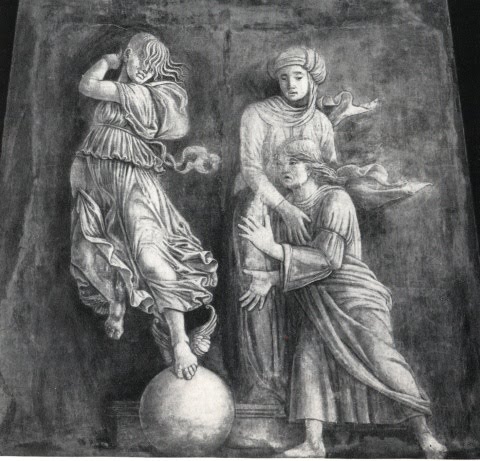Owing to the Christmas holidays, I had not yet received on Interlibrary Loan one of O’Neill’s sources, Stanislaus Klossowski de Rola’s Alchemy: the Secret Art. It came after my posting. In that book there is a series of manuscript illustrations that makes me question my former position. O’Neill found suggestions of two tarot trumps there; I find fifteen or more.
De Rola says the manuscript is 15th century. But when in that century? That is important when considering its relationship to the 15th century tarot: if in the first third of the century, then it is before any tarot we know of. If it from the last third, then it is after the first tarot. Also, what is in the text that accompanies the pictures? I ask that because the pictures, while reminiscent of later alchemical images, also have features that make them unique. So my post divides into two parts: the manuscript and the images.
THE MANUSCRIPT
First, a summary of what I have found out so far. The manuscript is from the first quarter of the 15th century, according to Setti. The text is a moralizing Christian interpretation of the Greco-Roman gods, with no apparent reference to alchemy. No art historian I have found mentions anything about alchemy in relation to either the text or its illuminations. De Rola, in turn, makes no mention of the Christian moralizing element. Yet the illuminations are unquestionably the same. Two sources that I have not yet examined are Liebeschutz’s 1926 book-length study of the ms. (in German) and an article by Panofsky that apparently gives the date as c. 1420.
Now the details: The manuscript, as de Rola gives it, is Apostolica Vaticana, Cod. Pal. Lat. 1066, In searching for information about it, I found an article on the Web by Salvatore Settis, a professor at Pisa, entitled “Danae Verso Il 1495,” in Italian. He is speaking about one illumination in particular, of the mythical princess Danae, upon whom Jupiter descended in a rain of gold:
My attempt at translation: “Danae to 1495,” by Salvatore Settis. “...The first, and most diffused, is what one meets in the illustrations of an edition (not in its original form) of the Fulgentius Metaphoralis, as in MS Vat. Pal. Lat. 1066, f. 228r, of the first quarter of the XV century. Here a dense, rhymed text (where Danae is "situ sublimata, menibus vallata, egestate sata, agmine stipata, prole fecundata, auro violata" is illustrated showing a solitary Danae on top of a closed tower, surrounded by teams of armed men, while she is receiving the golden rain...”La prima, e più diffusa, si incontra dell'illustrazione di una redazione (non quella originaria) del Fulgentius metaphoralis: così nel MS Vat. Pal. Lat. 1066, f. 228r, che è del primo venticinquennio del sec. XV. Qui un testo denso e rimato (dove Danae è "situ sublimata, menibus vallata, egestate sata, agmine stipata, prole fecundata, auro violata”) è illustrato mostrando una Danae solitaria in cima a una chiusa torre, circondata da schiere di armati, mentre riceve la piogga d’oro.
I found a translation of the Latin rhymes in an essay entitled “Emulating sensual beauty: representations of Danae from Grossaert to Rembrandt,” by Eric Jan Sluijter, (Simiolus 1999, p. 5, http://www.jstor.org/pss/3780877): “on an elevated spot, surrounded by fortifications, in great misery, encircled by troops, pregnant with offspring, violated by gold.” He attributes the translation to Erwin Panofsky, in an article entitled “Der gefesselte Eros (Zur Geneologie von Rembrandts Danae).” Panofsky dated the manuscript to 1420, according to Sluijter.
Panofsky’s article is available on the Web (http://books.google.com/books?id=GXWSs7 ... &q&f=false), but I do not find where he mentions the date; however it may be on the page just before the illustration, which Google omits. (So I have made another Interlibrary Loan request.) Here is the illustration, which I scanned from Sluijter’s article. It is in the same style as the illustrations that de Rola uses, as will be evident, and quite different from other manuscripts on the same theme; thus it is clearly from the same manuscript.
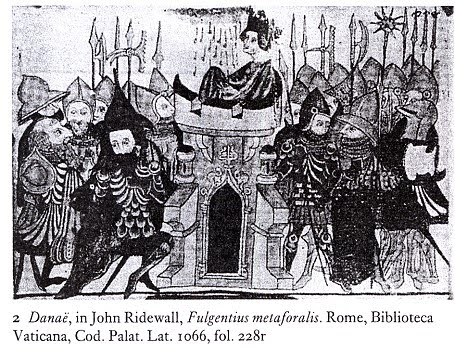
Danae’s myth was sometimes used in alchemical texts, notably Coenders van Helpen’s Tresor de la philosophie des ancients, Cologna 1693 (http://2.bp.blogspot.com/_5e7P4Y3Wo3w/T ... /Danae.jpg, from Fabricius p. 42). So the illustration might well have an alchemical point, as well as illustrating the verse about Danae in the text.
So now I have two sources. Settis says that this manuscript is from the first quarter (assuming that is what “venticinquennio” means) of the 15th century. Panofsky says that his manuscript, with the same title, the same Latin rhymes about Danae, and the same illustration style, dates to 1420.
Neither, let us make clear, is the original Fulgentius Metaphoralis According to various sites on the Internet, that happened in the 14th century. The author was an English Franciscan friar named John Ridewall, or in Latin Joannes Ridevallus, who flourished c. 1330.
Checking further, I see that Ridewall cites as one of his sources a work called Mithologia Alexandri Nequam (Seznec, Survival of the Pagan Gods p. 171, at http://books.google.com/books?id=YOISgW ... &q&f=false. Seznec thinks that this Nequam, or Neckam, is identical to the “Abricus” who authored a text called the Liber ymaginum deorum, which was a source for, and included in the same manuscript (Codie Reginsensis 1290) as the De Deorum Imaginibus Libellus, whose drawings were an inspiration for the images of the planetary gods in the “Tarot of Mantegna,” as Seznec later shows. The Fulgentius Metaphoralis is a text of the same type. The illustrations to the Libellus are like those of the Fulgentius; yet the Libellus has no suggestion of alchemy. Seznec gives an example in his Survival of the Pagan Gods, his figure 68, “Apollo and the Muses,” p. 177. I will compare that one to the one in the Fulgentius in the second section.
Just to guard against confusion, I should mention that there is another manuscript of the Fulgentius Metaphoralis, Palat. Lat. 1726. Seznec gives an illustration from that one that clearly betrays the moralizing intent of the text, a “Venus-Luxuria,” his fig. 31, p. 107. The style is noticeably different.
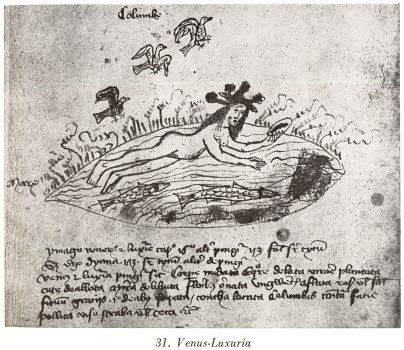
Seznec discusses the Fulgentius Metaphoralis of concern here, Pal. Lat. 1066, in some detail. In fact, he summarizes the text that goes with one of the illuminations that de Rola says is alchemical. Seznec first states Ridewall’s general framework. He assigns different gods to different virtues. Saturn is Prudence, and since the parts of Prudence are Memory, Intelligence, and Foresight, each of these virtues gets assigned to a different one of Saturn’s children, as well as their sum, Benevolence, assigned to Jupiter. He does the same for those gods’ children. Then Seznec comments specifically on Juno, to give us a sample:
All of this is on pp. 94-95, at http://books.google.com/books?id=YOISgW ... &q&f=false. Part of the actual Latin text on Juno is given, in Latin with English translation, on p. 106. And here is the illustration itself (omitted by Google in its copy of the page); you can see that it is the same as the one that de Rola reproduces (http://2.bp.blogspot.com/_5e7P4Y3Wo3w/T ... 0/iris.jpg), which I will discuss from his point of view later. Seznec observes (p. 169f) that “Iris’s rainbow” (the colors do not show) “forms an aureole on Juno that might be the halo of a saint”; i.e. the illumination carries out the Christian moralization of the Greco-Roman goddess.The detailed working out of this allegorical analysis is caried to fantastic extremes. For instance, Juno, as we have seen, is identified with Memory, and therefore has the following attributes: she is veiled, crowned with a rainbow, crowned with a rainbow, and perfumed; she holds a scepter, is bound by a golden chain, surrounded by peacocks, etc. All these details are explained by the very fact that the goddess represents memory.
Memory does, of course, keep alive the recollection of sin; hence the veil behind which Juno may hide her shame. The recollection of sin leads to repentance, and thus to reconciliation with God; this explains the rainbow, sign of divine forgiveness. Reconciliation gives birth to spiritual consolation, which fills the soul with rapture: hence the perfumes. And having, by virtue of Memory, attained repentance and reconciliation, the soul in its new state of blessedness regains that mastery of itself which sin had caused it to lose: hence the scepter, etc. The extraordinary ingenuity of the commentary is apparent, especially when we consider that each interpretation rests upon at least one supporting authority—Cicero, St. Augustine, or Bernard of Chartres. This is without doubt our most curious monument of the application of Christian allegory to mythology.
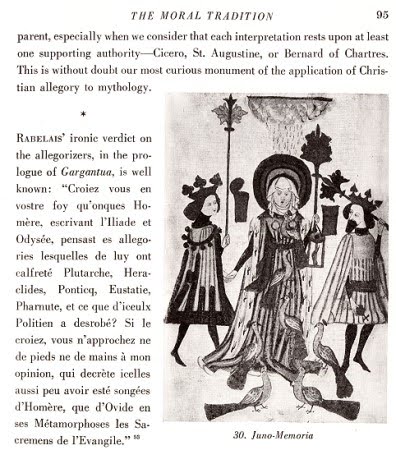
Seznec finds this treatment of the Greco-Roman gods to be “most curious.” Well, de Rola gives an alchemical analysis of this same illustration. What would he make of that? And O’Neill finds tarot symbolism in other illustrations of the series. I even find it here. Where did those trashcan-like things on either side of “Juno” come from, one of which looks like the tower in “Marseille” Tower card? (It looks like alchemical apparatus. The resemblance of the Tower card to images of such apparatus has been noticed before, e.g. http://www.legends-and-myths.com/40_2.c ... utus-liber), but not, to my knowledge, in relation to images this early. Furthermore, the match-up is closer than to anything in the 1677 Mutus Liber.) What about the lantern in her hand, like the Hermit’s? Who are the King and Queen on either side, like the Emperor and Empress, or the two young people flanked by an older woman on the “Marseille” Lover card? Juno, after all, was the goddess of marriage. Then there is the relationship to the text. How could that headgear, like the Popess’s, hide her shame? Where is the “golden chain” mentioned by the text? Curioser and curioser.
THE IMAGES
Now I will present the images, along with de Rola’s short comments on each, plus my own comments on de Rola and how I find the image related to the tarot. I am presenting the illuminations in the order they occur in the text rather than that in which de Rola presents them, with the exception of 1 and 2.
(1) I am not sure which page in the manuscript comes first, 218 or 218v. De Rola puts 218v first, as his plate 53. Here it is.

De Rola comments
The picture, O’Neill reasonably contends, brings to mind that of the tarot CHARIOT card, especially the Noblet with its dark and light horses. The reddish and whitish horses, which many speculate are the noble and ignoble horses of Plato’s Phaedrus, are now the red and white of alchemy. The black of the raven is the third. O”Neill says that the Charioteer corresponds to the King’s Son in alchemy (Tarot Symbolism p. 278). You will notice that in this sequence of illustrations (if indeed they form a sequence) there are two men wearing crowns, one bearded and older, the other clean-shaven and younger.The nine Muses are seen here with their patron Apollo, who is sitting in his chariot and holding his bow and the arrow of the secret fire. The red colour (pl. 54) indicates the sulphur of the philosophers; the raven, the nigredo. The Tree of Life (in the chariot) is frequently associated with Apollo.
Seznec (p. 170) calls the man on the horse a “postilion,” i.e. someone who guides the horses who is on one of them rather than in the chariot. One early tarot Chariot card, c. 1450, also has such people (http://trionfi.com/0/j/d/ferrasingle/, and another, the CY, is not far off, with its groom standing next to the horse (http://a-tarot.eu/test/cary-yale-chariot.jpg).
I have never before seen a pre-18th century alchemical illustration that included a chariot, except perhaps another illustration that de Rola gives, from 1480, which has all the planetary gods on chariots, but then this one is earlier than most alchemical images. The chariot was a popular motif of the times. With so many other images of chariots, the tarot did not need this picture to prompt its own: but the coincidence is suggestive.
The above picture can profitably be compared with the one in the Libellus of the same scene (Seznec p. 177).
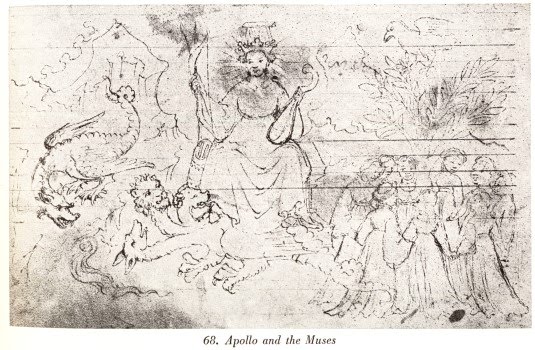
The other picture’s suggestions of alchemy are noticeably absent here. Another difference is the drawn bow vs. his holding it at his side. The drawn bow suggests that Apollo has not yet slain the Python-dragon. It also suggests the dragon-fight to come that is often part of alchemical works.
(2) Here is the other illumination, ms. f. 218, de Rola’s plate 55.
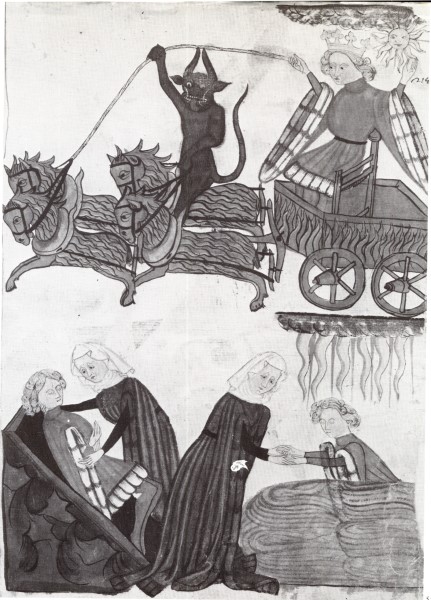
De Rola’s comment:
At the bottom of the illumination, the tomb, at which the lady assists, is very much like the Egg de Rola mentions. There is a certain resemblance to the JUDGMENT card, although nothing that was not commonplace in the culture of the time.The frequent alchemical references to death, burial and rebirth mean that the subject is sealed inside the Egg to decay and be reborn in glory. The philosophers have often depicted the life of Christ in this esoteric light.
At the top, the chariot may be such an Egg, but one on wheels. It is an Egg in which the Young King will undergo the fires of hell before his triumph.
This one again resembles the tarot CHARIOT. In addition, there is a red DEVIL. Again, the tarot did not need this image to inspire it, but it is one of the few actual devils I have seen in alchemical illustrations. Here the Young King is not in armor.
You will have noticed that the lady looks the same as that of “Juno” in the Seznec illustration. Since when did Juno help people out of graves?
It would be of interest to know what the text is corresponding to this image. I can deduce nothing from Seznec. Hopefully Liebeschutz’s book (another Interlibrary Loan request) will have something.
(3) Then comes the Royal Pair, on their cauldron-like throne, f. 221, de Rola’s plate 56:
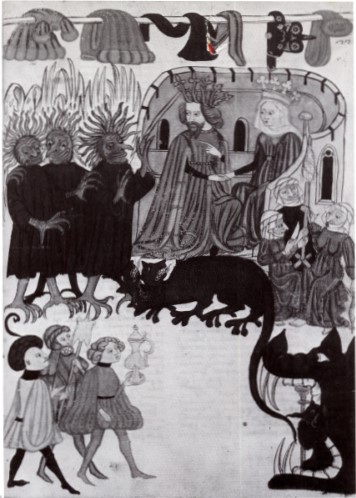
De Rola says:
Clotho and her spindle are reminiscent of the Charles VI SUN card. The demons are suggestive of the ones on the “Marseille” style DEVIL card. Again, it would be nice to know what the corresponding text is.The Green King must die. The hideous Stymphalides (death-bringers, like the Harpies in pl. 54) are summoning him, and the Three Fates are about to end his life; Atropos cuts the thread spun by Clotho and measured by Lachesis. This king represents the root, the primordial source from which all things grow.
(4) Now comes something quite different, plate 54, on f. 222 of the manuscript.
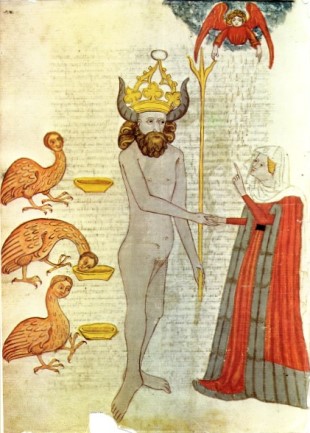
De Rola says:
De Rola’s plate 2 is the first image of the 17th century speculum veritatis, which can be seen at http://www.labyrinthdesigners.org/wp-co ... atis-1.jpg). The wolf is on the right. A clearer picture of what he is doing is in Maier’s 1618 Atalanta Fugiens, Emblem 24, http://www.tarotgarden.com/library/imag ... s_1618.jpg. Maier’s motto for this emblem is “The wolf devoured the King and, cremated, restored him to life.”It is likely that the king’s nakedness and whiteness, and the horns on his head, refer to the operation of calcination or purification, which is associated with the Zodiacal sign of Aries the Ram (see note to pl 2). The woman is wearing a red cloak trimmed with grey, the colour of Jupiter; her belt is black, the colour of Saturn. The subject is emerging from the black shadow of death, hence his victorious crown. The Harpies, offspring of Earth and Sea, were as deadly as their cousins the Sirens (pl. 46); their sister was Iris (pl. 57).
De Rola’s note to pl. 2 says
The sign of Aries corresponds to the name of the Materia Prima or subject of the Work. The grey wolf (antimony), devouring Mercury, indicates that a purification of the subject, similar to that of gold by antimony, must take place.
I would have thought that Aries signifies the King’s role as sacrificial lamb, like Jesus. It suggests to me that the King’s death and purification (at the Easter season) is about to occur, not that it has already occurred. I don’t know why the crown should indicate only victory; in the Rosarium series the King wears it before, during, and after death; it identifies him.
The lady looks to me like she’s instructing the King about something, while the deluge threatens; that is the role of the POPESS.
The lady is probably not the man’s wife/lover, since she doesn’t have a crown, and the figure on high is not a Cupid, but nonetheless the arrangement is similar to the 15th century LOVE cards, especially the CY and PMB.
The King and Queen correspond to the EMPEROR and EMPRESS cards. O’Neill makes this point in reference to later alchemical sequences (Tarot Symbolism p. 276f) and it applies here as well. Alchemy reserves the Emperor’s crown for people at the end of the sequence, as a kind of promotion after going through hell. A later illustration of the Bearded King by himself (#6 in my list) is quite close to that of the EMPEROR card, as O’Neill notes.
(5) This is f. 223, de Rola’s plate 57. It is of course the one that Seznec analyzed in detail (see first section of this post), as corresponding to the text’s account of Juno.

De Rola explains
The lady is Iris, the rainbow, Juno’s messenger, the harbinger of death to women, as Mercury is to men. To release the souls of women, in alchemy, means to sublime the volatile parts of the residue after the nigredo, thus producing the rainbow colouring which is called the Peacock’s Tail.
Is the lady in the center Iris or Juno? She looks like the Roman statues of Juno (http://en.wikipedia.org/wiki/File:Juno_ ... ushkin.jpg) and coins (http://en.wikipedia.org/wiki/File:Denar ... C_0237.jpg), where she wears a hooded garment and stands holding a long scepter or spear. By 1420 artists probably knew to pay attention to such classical models. Iris, in contrast, had wings and a caduceus, Yet the role of this hooded figure in her various appearances in these miniatures is more that of Iris, which in the Iliad was much like that of Hermes in the Odyssey, per Wikipedia: both were conveyers of souls after death. Moreover, Seznec identifies the bearded king on the next page as Jupiter. If the king here is the same, as they appear to be, that would make the Queen Juno, and the hooded lady someone else.
I have already pointed out how the lady resembles the POPESS, the scene that of the “Marseille” LOVER card, the holding of the lantern that of the HERMIT, and the trashcan-like things like the “Marseille” TOWER. Alchemically, the trashcan-like things are simply pieces of alchemical apparatus. Here are examples in clear-cut alchemical texts, on the left 15th century, on the right 16th century (Laurinda Dixon, Bosch, p. 193, of Trinity College Library Cambridge MS 0.8.1 f. 1r and Wellcome Institute Library, London, MS 719 f. 256).

(6) This one is ms. f. 224v, de Rola’s plate 59. Seznec (p. 169) says that this image is of Jupiter (as does O’Neill at http://www.tarot.com/about-tarot/librar ... ll/emperor), and that the inclusion of “a flight of heraldic eaglets” is quite “ingenuous,” which I think is probably a mistranslation for “ingenious,” an adjective that the English translation used earlier. The eagle is of course the bird of Jupiter.
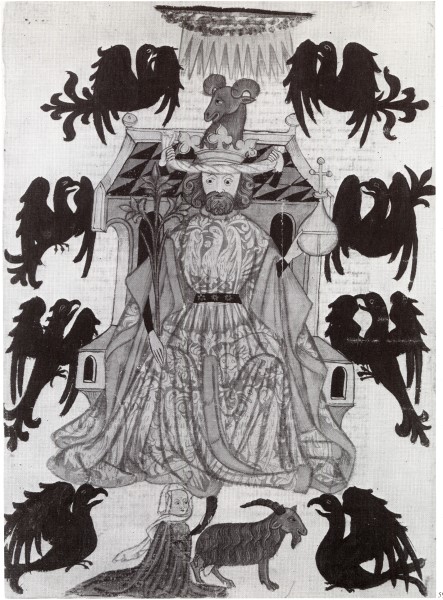
But why eight? Here is de Rola:
De Rola is giving an alchemical explanation of the proliferation of eagles, as signifying death by evaporation, followed by rebirth as the sublimate that sticks to the side of the container.Here again, the king is about to meet his doom (see notes to pls. 55, 56). The eight eagles symbolize repeated sublimations. In his left hand the king holds the orb, which is a hieroglyph of the name of the subject, corresponding to the celestial sign of Aries. In this sense the death alluded to is a fixation of the volatile, whereby Water becomes Earth.
And here is O’Neill (Tarot Symbolism, p. 277) on this image
...the King is shown in royal state, much as he appears in early hand-painted Tarots and is even surrounded by black eagles which frequently appear on the shield of the Emperor card.
Except for the great quantity of eagles, his point is well taken. The EMPEROR card shows just one, on the shield or hat. Allowing also for the rams and the omnipresent lady, this image approximates the card.
(7) The next is ms. f. 226, de Rola’s plate 58.

De Rola says:
You will notice the penis and testicles in the hand of the Young King, who gives it to a pair of children. I do not know what the Christianizing text makes of this scene, but for me it relates to the FOOL card. The FOOL on two early tarot cards, the d’Este and the Charles VI, is much the same as the Saturno of the “Tarot of Mantegna” (http://2.bp.blogspot.com/_5e7P4Y3Wo3w/T ... naFool.jpg) The children reach up on the d’Este, just as the dog-like creature does on the Noblet (http://www.tarot-history.com/Jean-Noble ... le-fou.jpg). The Old King is depotentiated, the youngsters empowered. (In alchemy, it is the fixation of the volatile and the volatilization of the fixed. See my post at viewtopic.php?f=23&t=383&start=80#p9705 and my long one preceding it on that thread.)Saturn holds a sickle; Rhea a stone. He had castrated and deposed his father Uranus; and to avoid the same fate, ate all his own children. Once Rhea substituted a stone; and the child, Jupiter, grew up to castrate and depose his father. Myths of this kind reflect the cyclic nature of the Great Work.
(8) We come to ms. f. 227, de Rola’s plate 60.

De Rola:
Seznec would undoubtedly say that this picture is to illustrate the god Mercury, from whom the text draws moralizing lessons. His killing of Argus is in numerous of these “Ovid moralized” texts, including the Libellus, from which the “Tarot of Mantegna” took its image of Mercury standing on Argus’s head. But in this sequence he is also the scepter-bearing Bearded King of another story.Mercury kills (or fixes) Argus, the hundred-eyed guardian. Argus’ charge, the cow Io, was said by the Greeks to change colour with the phases of the Moon: black, white and red. It was Argus’ eyes that went to decorate the peacock’s tail (see pl. 57). The weaponry alludes, as always, to the secret fire.
I relate this image to both JUSTICE and STRENGTH, and perhaps also TEMPERANCE and the BAGATTO/MAGICIAN, although the correspondences are not close. The Bearded King (with a hat of Mercury similar to that in the “Mantegna”) wields the sword, while the Queen does the cooking. The alchemist had to add ingredients to his stew in precise proportions. Later alchemical illustrations would have had a scales here as well as the fiery sword (the two implements of the JUSTICE card), to get the amounts right (see e.g. the lady at the top right in an illustration from “Alchimia,” http://2.bp.blogspot.com/_5e7P4Y3Wo3w/T ... apollo.jpg). Here all we have is different sized pots. Fluids had to be mixed, too, as in the TEMPERANCE card. The two personages stand in front of a table with various items on it, like the BAGATTO’s. And the slaying of Argus is Mercury’s version of the dragon-fight, as depicted with a lion in the PMB STRENGTH card.
(9) This one is f. 230v, de Rola’s plate 62. It has two scenes, one on top and the other below.
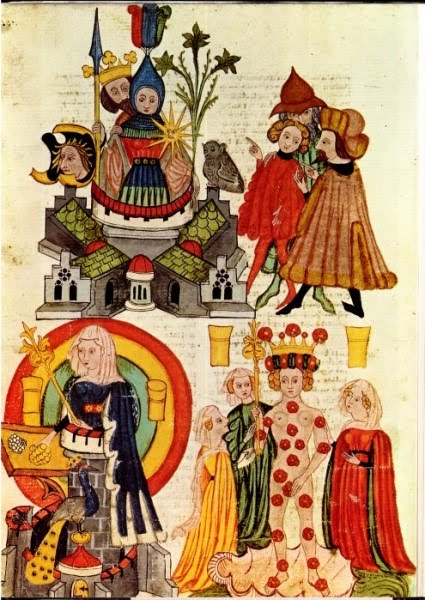
De Rola says:
De Rola’s plate 22 (http://4.bp.blogspot.com/_5e7P4Y3Wo3w/T ... 286f11.jpg), is from the same 17th century ms. as Plate 2, the Speculum veritatis. The lady is at the top. He does not say more about her.In a castle which represents the philosopher’s furnace, Lady Alchimia (see pl. 22) dwells in state with her consort the Athanor King. In accordance with the maxim ‘no generation without corruption’, she carries a shield with the head of Medusa, emblem of the black putrefaction which is indispensable to the alchemical process. Below she appears in the guise of Iris; and on the right Venus stands on her scallop shell, her body all roses; the red flowering out of the white.
De Rola’s expression “dwells in state” means that they are corpses in a tomb, a typical alchemical image. It does not seem to me that the lady is holding the shield. It merely flanks the tower, a symbol of death like the owl on the other side. She is suffering death, not inflicting it. Here the Queen looks very much like Juno.
On the bottom, the hooded lady would be Juno again, if Seznec is right. But between this image and the one before it, on f. 228, was the picture, omitted by de Rola, of Danae in her tower being rained on with gold (http://3.bp.blogspot.com/_5e7P4Y3Wo3w/T ... ae1066.jpg). Similarly, this lady is in a tower, producing gold and silver, and below her one of the peacocks, usually associated with Juno, has a tail like a shower of gold.
Notice here what I have called the “trashcan” motif, suggestive of the TOWER card. Yet it is Venus who wears the crown. She is on a clamshell, and thus she is the metamorphosized semen of Saturn’s testicles, which were shown several plates back, the Old Queen renewed. As the only naked lady in these illustrations, she corresponds to the card after the Tower, the STAR, which from the Cary Sheet on has the only all-naked lady in the tarot sequence.
(10) And finally f. 239, de Rola’s plate 61.
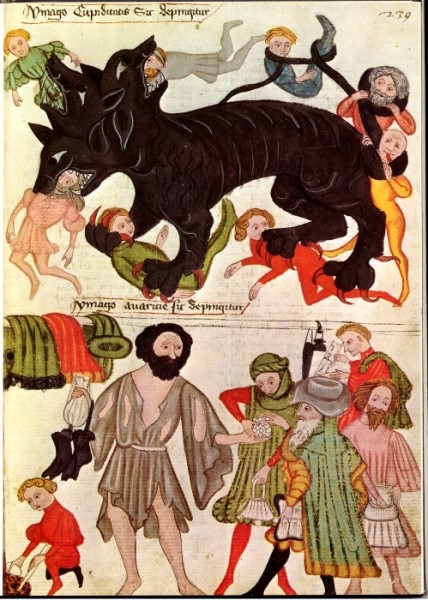
De Rola:
De Rola’s plate 27 is British Museum Sloan ms. 2560, f. 6, which he says is 15th century and attributes to Johannes Andreae. Wikipedia has Andreae as late 16th-early 17th century, the producer of the printed Marriage of Christian Rosenkreuz, allegedly from an earlier manuscript. So I am not sure what century to give the image. The Sloan ms. shows a man and a woman in a flask facing each other holding hands, with a small child standing in the neck of the flask above them (http://4.bp.blogspot.com/_5e7P4Y3Wo3w/T ... loanMs.jpg).Above, Cerberus, the three-headed hound of Hell, devours the subject of the Work eight times over through the agency of the secret fire. Below, the subject, stripped of impurities (see pl. 27), is ready to be cooked in the Egg until perfection is reached.
The top scene is the repeated distillation and sublimation of the substance, relating to various cards (HANGED MAN, DEATH, TOWER, JUDGMENT). The bottom scene, where the alchemist gives out the silver coins made by the lady in the preceding scene, suggests the WORLD card: with silver, he has the material world, and with the elixir, its medical equivalent, he has eternal life.
I think by now I have mentioned every tarot trump except the MOON and WHEEL OF FORTUNE. I also need to say more about the HANGED MAN.
De Rola hasn’t given us any image corresponding to the MOON, but then he hasn’t shown us all the illuminations in the manuscript. I will look in Liebeschutz, who has them all, when I get the book. The MOON has a rather obvious correlation in alchemy, the whitening that occurs right before the solar reddening, as recounted, for example, in a spurious letter from Cosimo di Medici to Pius II, copied in a 1475 manuscript (Thorndike, History of Science and Magic. vol IV, p. 346 in the chapter starting at http://books.google.com/books?id=IbvlQF ... &q&f=false).
I am not sure what in these early texts corresponds to the WHEEL: my guess is, the repeated operations of distillation and sublimation done to purify the substance, each a going up and coming down. The nearest equivalent in what we have seen is the eight eagles. The HANGED MAN is probably more of the same, a scene of suffering and a prelude to death, such as suffered by the substance in the course of purification. An alchemical text with both (and something like the PMB Strength) is the early 15th century (first produced c. 1411-1420) Buch der heilegen Dreifaltigkeit. The relevant page, from St. Gallen’s copy, is at http://2.bp.blogspot.com/_5e7P4Y3Wo3w/T ... ilegen.jpg (Laurinda Dixon, Bosch, p. 269). Similar images are in copies of the book in Dresden and Munich. For Munich, see e.g. http://daten.digitale-sammlungen.de/~db ... =4&seite=8, from a link that Huck gave on the “Fool” thread, http://www.handschriftencensus.de/werke/2246. As Huck points out (viewtopic.php?f=23&t=383&start=80), the father of Barbara of Brandenburg, Duchess of Mantua and a close friend of Bianca Maria Visconti, acquired a copy of this book in 1432. Barbara arrived in Mantua 1436/1437.
I will probably have more to say after I get the material in German, by Panofsky and Liebeschutz.

